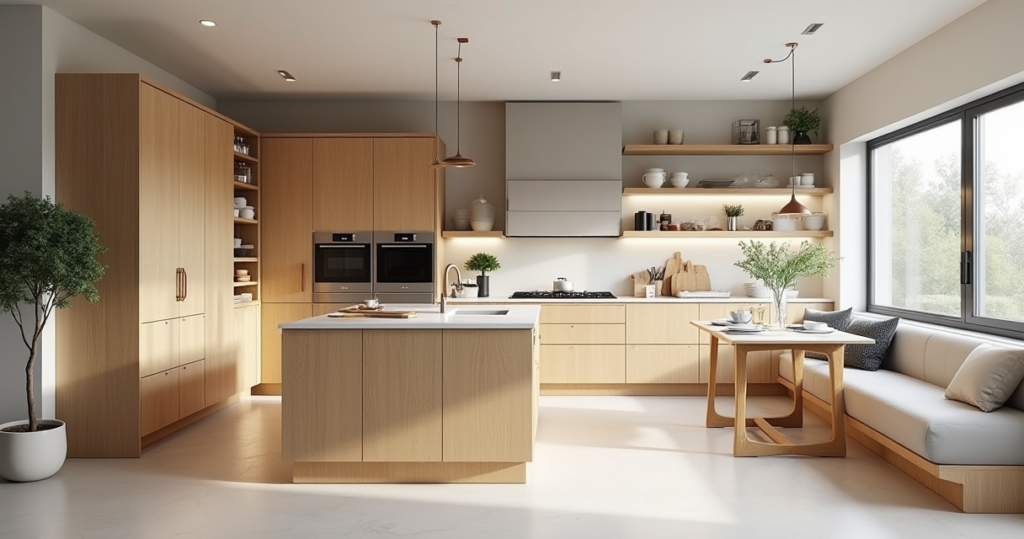Picture this: You’re standing in a kitchen filled with warm, golden light. On the wall behind the stove, a splash of brilliant, hand-painted tiles tells a story of generations of craft. The air smells like coffee and cilantro. You run your hand over a wooden countertop, worn smooth by years of love and cooking. This isn’t a showroom, my friend. This is a kitchen with a soul. This is the kind of space that invites you in, that feels like a hug, and it’s what I want to help you create.
You asked me about renovating your kitchen, and I’m so glad you came to me instead of getting lost in a sea of generic advice. Everyone is obsessed with creating a “dream space,” but that so often translates to a cold, white box that looks like everyone else’s. The real secret to a kitchen you will love for decades is to fill it with your story, with warmth, and with the touch of human hands. Let’s talk about how to do that, step by step.
Strategic Planning for Your Dream Kitchen Transformation (Part 1)
Before you even think about a single tile or cabinet color, you have to get the foundation right. This is the part everyone wants to skip, but it’s the most important. This is where we figure out the rhythm of your home, the heartbeat. It’s about designing a space that truly works for how you live, not just for a pretty picture online.
1. Define Your Kitchen’s Core Purpose & Lifestyle Needs
Can we talk about why everyone gets this wrong? They start with a picture on Pinterest. A look. A trend. But a kitchen is so much more than a look; it’s the heart of the home, el corazón. So, the first thing you have to ask is not “what do I want it to look like?” but “what do I want it to feel like?” Is this where your kids will do their homework while you chop vegetables? Is this where friends gather for wine and conversation? Is it a quiet sanctuary for your morning coffee?
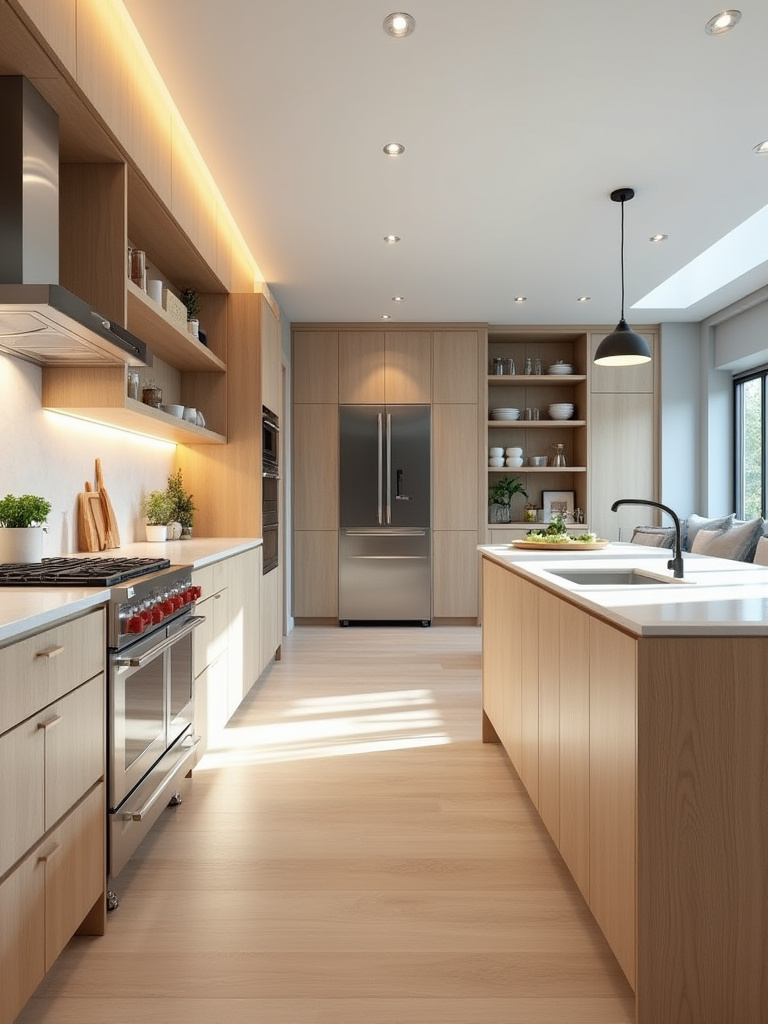
Forget the corporate-speak about “workflow efficiency.” Think about the flow of life. I once had a client, a wonderful family from Peru, who was torn between a giant, sterile island and a more traditional layout. I asked them to tell me about their best family memories. They all involved rolling out dough for empanadas together on their grandmother’s big wooden table. That was it. We designed a massive, warm butcher-block island at table height, a piece that invited everyone to gather around. That’s what matters—not some abstract rule, but the memories you want to make.
This is the phase for daydreaming and deep honesty. So, before you do anything else, grab a notebook and map out the life you want to live inside these future walls.
2. Establish a Realistic Renovation Budget & Contingency Fund
Alright, let’s talk money. It’s not the most romantic part, but getting it right means you can actually enjoy the beautiful things without stressing. The biggest mistake people make is thinking of their budget as one big number. It’s not. It’s a series of choices, and you need to decide where you want to put your soul—and your dollars. Do you splurge on the hand-painted Talavera tiles that make your heart sing? Yes. Do you need the fanciest smart-fridge that talks to you? Probably not.
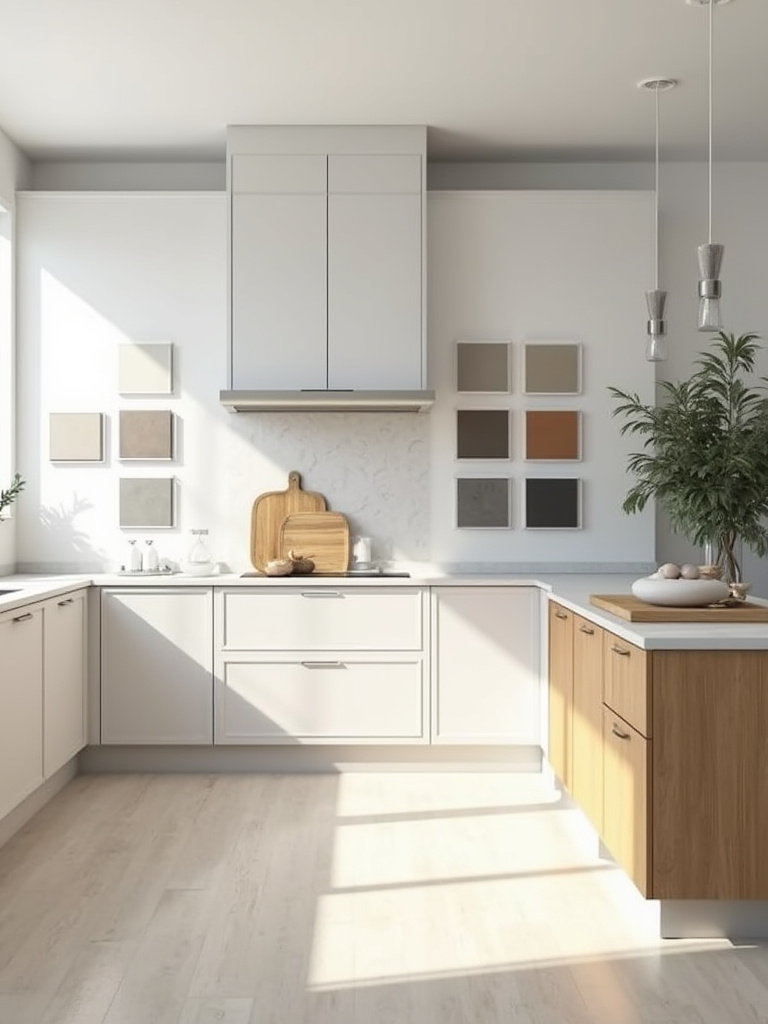
What you absolutely need is a contingency fund. I’m talking 15-20% of your total budget, sitting there, waiting for the inevitable surprise. Last year, we were working on a beautiful old home and when we opened a wall, we found old plumbing that wasn’t up to code. It was a completely unexpected expense. My client didn’t even flinch, because we had planned for it. That fund is your peace of mind. It’s the difference between a project that flows and one that becomes a nightmare of compromises.
With a clear budget, you can decide what to prioritize. I always advise clients to invest in the things you touch every day—the countertops, the hardware, the flooring. Those are the elements that give you daily joy and will last a lifetime if you choose well.
3. Optimize kitchen layout for Maximum Workflow Efficiency (The Golden Triangle)
You’re going to hear a lot about the “Golden Triangle”—the path between your stove, sink, and fridge. And yes, it’s a good starting point. It’s logical. But culture and community add another layer. In a Latin American home, the kitchen is a dance, and sometimes there are many dancers. It’s not just about one person moving efficiently. It’s about making space for helping hands, for conversation, for someone to lean against the counter and share their day.
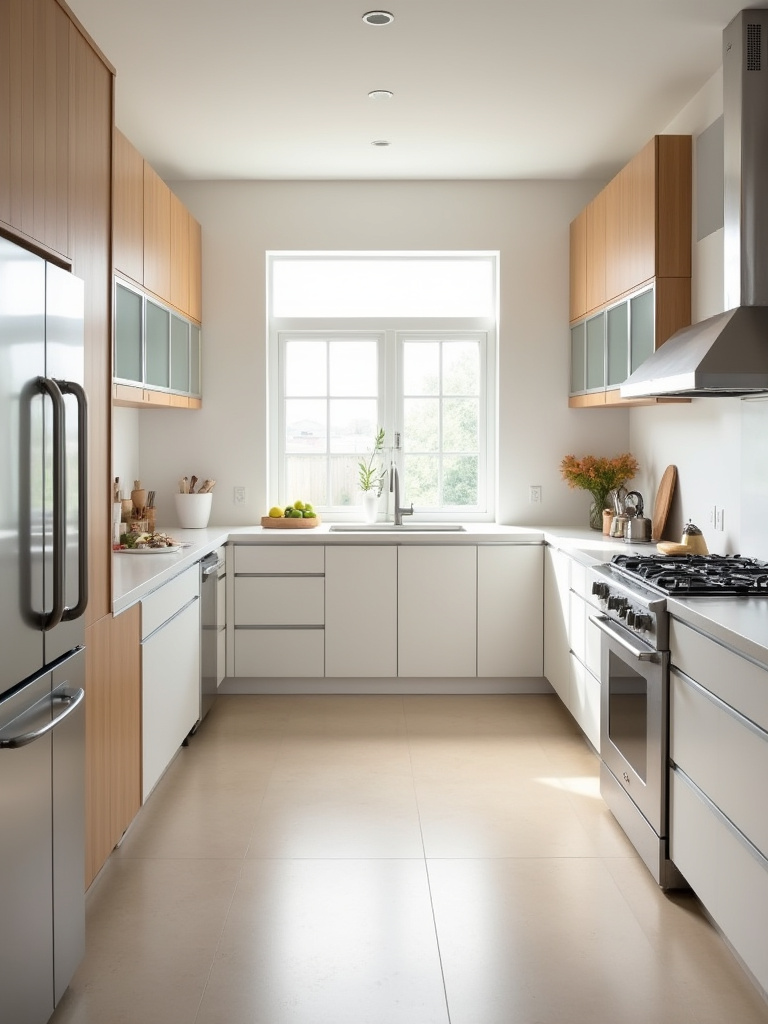
I like to think of it less as a rigid triangle and more as creating zones for living. You need your work zone, of course, where the magic of cooking happens. But you also need a “visitor zone”—a place where someone can sit and chop cilantro or just have a glass of wine out of your way. Maybe you need a baking zone for making pan dulce on Sundays. Don’t let a rigid geometric rule dictate the soul of your space. Map out the paths that people actually walk, not just the path from fridge to sink.
One of my favorite projects had a tiny, cramped kitchen. The official “triangle” was impossible. So we blew out a non-structural wall into the dining room, put in a long, narrow island, and placed the sink in the island facing the room. Suddenly, the person cooking was part of the conversation, part of the party. It broke all the rules, and it was the best decision we made.
4. Incorporate Smart Storage Solutions Early in the Design Phase
Storage isn’t just about hiding things away. It’s about creating a home for the beautiful tools of your daily life. It’s an opportunity to create little moments of beauty. Everyone says you need to maximize every square inch, and while that’s true, I say let’s do it with soul. Instead of just another boring cabinet, can we incorporate some open shelving to display those hand-thrown ceramic bowls from Oaxaca?
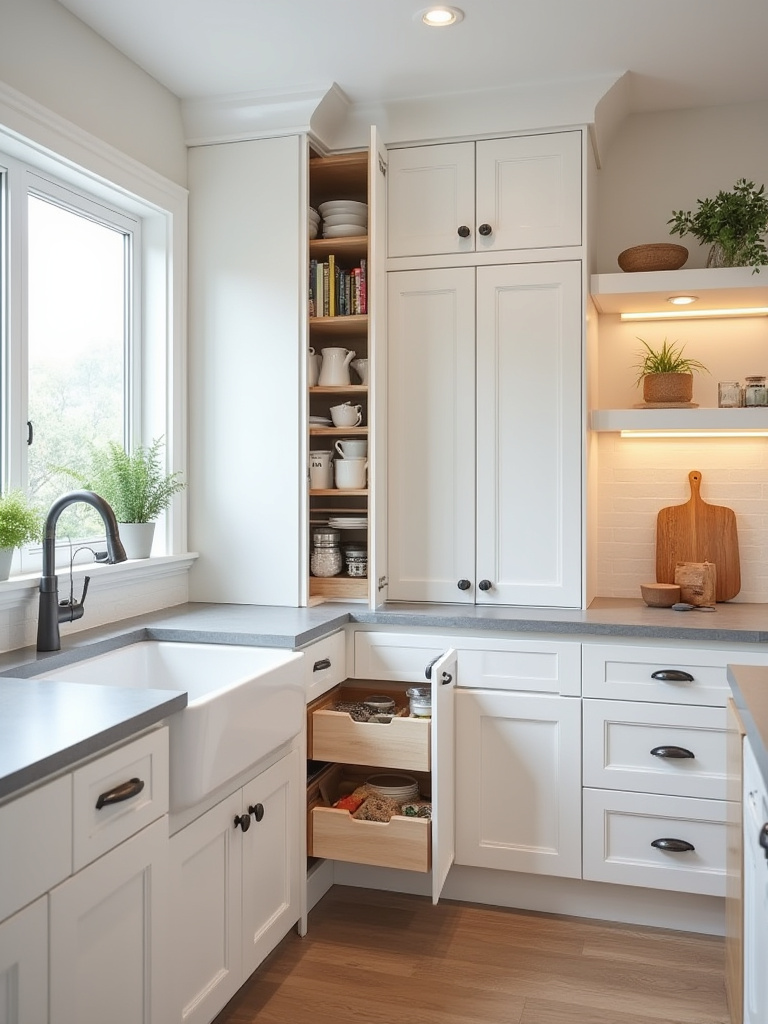
I confess, I used to think storage was purely functional. Then I worked with a woman whose kitchen was her sanctuary. She had a collection of beautiful, hand-painted jars for her spices and grains that she’d collected on her travels. We designed a shallow pantry with glass doors just for them. It wasn’t the most “efficient” use of space by a metric, but it brought her joy every single time she opened it. The noise of a generic kitchen is all about hiding clutter. What actually matters is creating storage that feels intentional and beautiful.
Think in layers. Deep drawers for pots and pans are a game-changer. A tall, pull-out pantry can hold an incredible amount of food. But also leave room for the things that deserve to be seen. A hanging pot rack with beautiful copper pans, woven baskets on a shelf for onions and garlic. Let your storage tell a story.
Strategic Planning for Your Dream Kitchen Transformation (Part 2)
Okay, so we’ve dreamed about the feeling and sketched out the flow. Now we get into the part that makes sure this beautiful vision actually becomes a reality you’ll love for years to come. This is about making smart, soulful choices that will last, and finding the right people to bring it all to life.
5. Consider Future Resale Value and Timeless Design Elements
You’ll hear a lot of talk about “resale value,” which usually means “make it neutral and boring so you don’t scare anyone off.” I say forget that. The most timeless design isn’t about being bland; it’s about choosing quality and authenticity. Handcrafted things, natural materials, and thoughtful design never go out of style. A countertop made from a single slab of beautiful, veined quartzite has more lasting appeal than whatever the trendiest laminate color is this year.
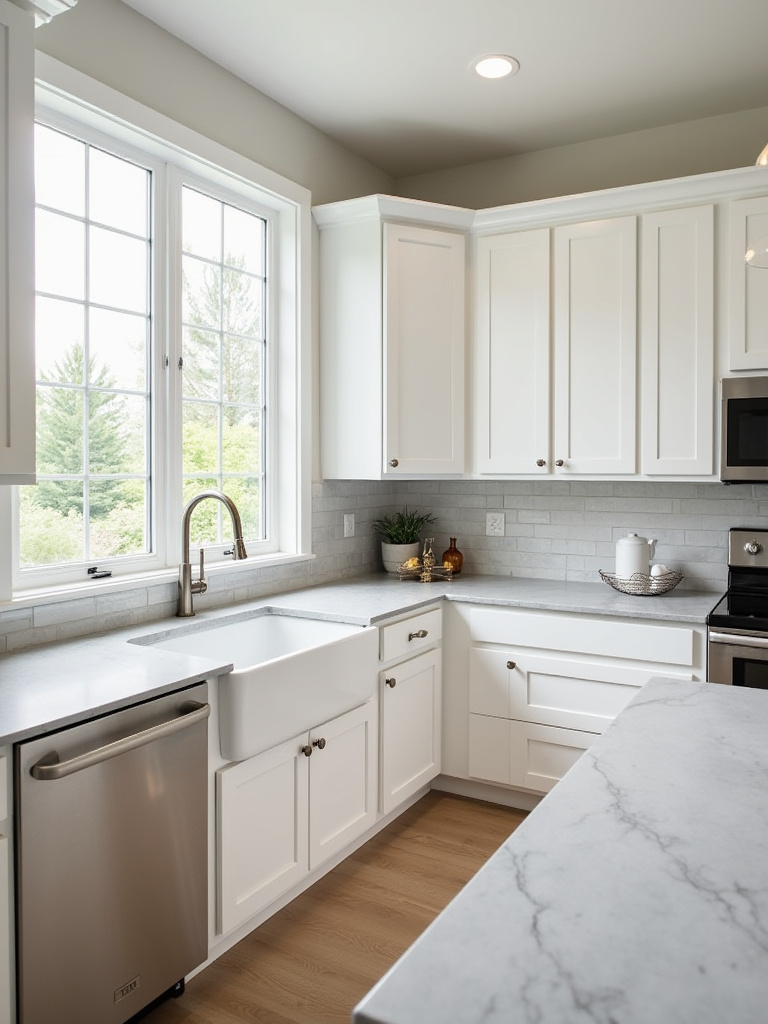
What truly holds value is craftsmanship. I once walked into a home where the owner had installed stunning, hand-carved cabinet doors made by a local woodworker. They were intricate and deeply personal. A real estate agent might say that’s “too specific,” but anyone who appreciates art and skill would see the incredible value. The shortcut here is to invest in natural, durable materials that gain character over time—wood that can be oiled, terracotta floors that develop a beautiful patina, stone that tells a story. That’s timeless.
So don’t design for a mythical future buyer. Design a kitchen that you love, using materials with integrity. That passion and quality are what will truly shine through and create lasting value, both for you and for whoever is lucky enough to live there next.
6. Interview Multiple Contractors & Vet References Thoroughly
This step is everything. You are not just hiring a contractor; you are inviting someone into your home to build its heart. You need to find a true partner, a craftsman who understands and respects your vision. The lowest bid is almost never the best choice. What you’re looking for is someone who gets excited about the details, who understands the materials, who you can communicate with openly.
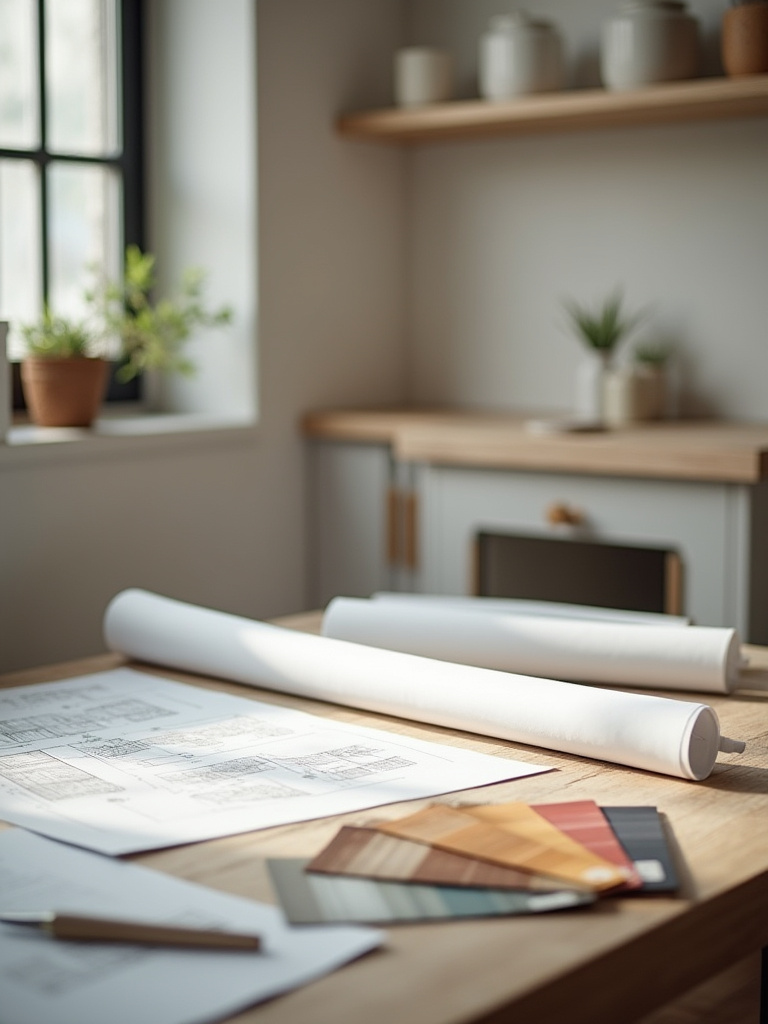
My hard-learned lesson? I once worked with a contractor who was technically skilled but had no soul. He just wanted to get the job done fast. We were installing these incredible handmade cement tiles, and each one was slightly different. He saw them as defective. He wanted perfectly uniform, factory-made tiles. It was a battle every single day to get him to slow down and appreciate the beauty of the imperfection. I learned then that you must find someone who speaks the same language of craft.
Ask them to show you their work. Ask to speak to past clients. But also ask them what they love about their work. Ask them about a project that challenged them. You’ll hear in their voice whether they are a builder or a true artisan. Find your artisan.
Smart Selections & Seamless Installation of Core Components (Part 1)
Now for the fun part—choosing the elements that you will see and touch every single day. This is where your kitchen’s personality really comes to life. These choices are the building blocks of the space, the textures and colors that will surround you. It’s about creating a symphony of materials that work together in harmony.
7. Select Durable Countertop Materials That Match Your Usage Habits
Your countertops are the workhorse of your kitchen. They need to be tough, but my god, they should also be beautiful. The noise is all about quartz, quartz, quartz. And it’s a fine, practical choice. But it can be a bit… soulless. What really matters is choosing a material that speaks to you and fits how you live. Do you love the organic feel of wood? A thick mesquite or walnut butcher block can be stunning, warm, and forgiving. It will show its age, but that patina is part of its story.
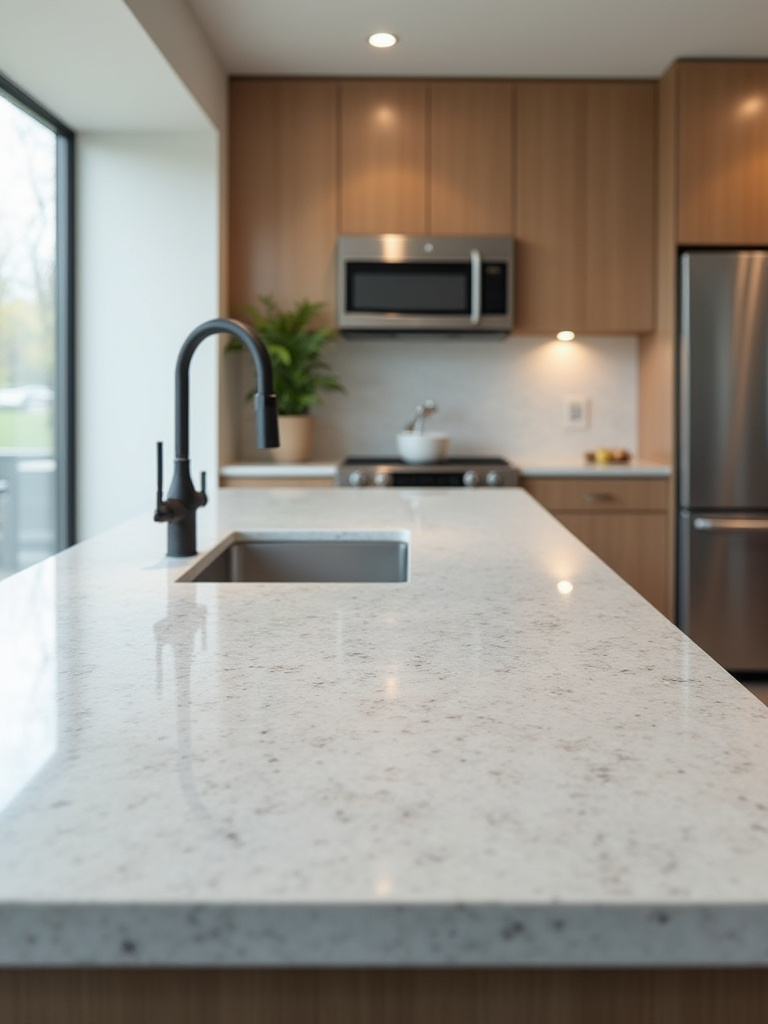
For a client who wanted something unique and earthy, we used Cantera stone, a volcanic rock quarried in Mexico. It has a gorgeous texture and a softness you just don’t get with granite. It requires sealing and a bit of care, but the trade-off is a surface with unparalleled character. Or consider polished concrete, which you can have custom-tinted to any color imaginable—a deep terracotta red, a soft sage green. These materials feel alive.
The key is to be honest with yourself. If you’re someone who is going to stress about every little scratch or wine ring, then a more indestructible material might be for you. But if you believe, as I do, that a life well-lived leaves its marks, then embrace a natural material that will evolve with you.
8. Choose Energy-Efficient Appliances for Long-Term Savings & Performance
This might sound like a purely practical point, but hear me out. Choosing energy-efficient appliances is, at its heart, an act of mindfulness. It’s about being a good steward of our resources, which is a principle deeply woven into many artisanal traditions. It’s about choosing quality that lasts, instead of something disposable that will end up in a landfill.
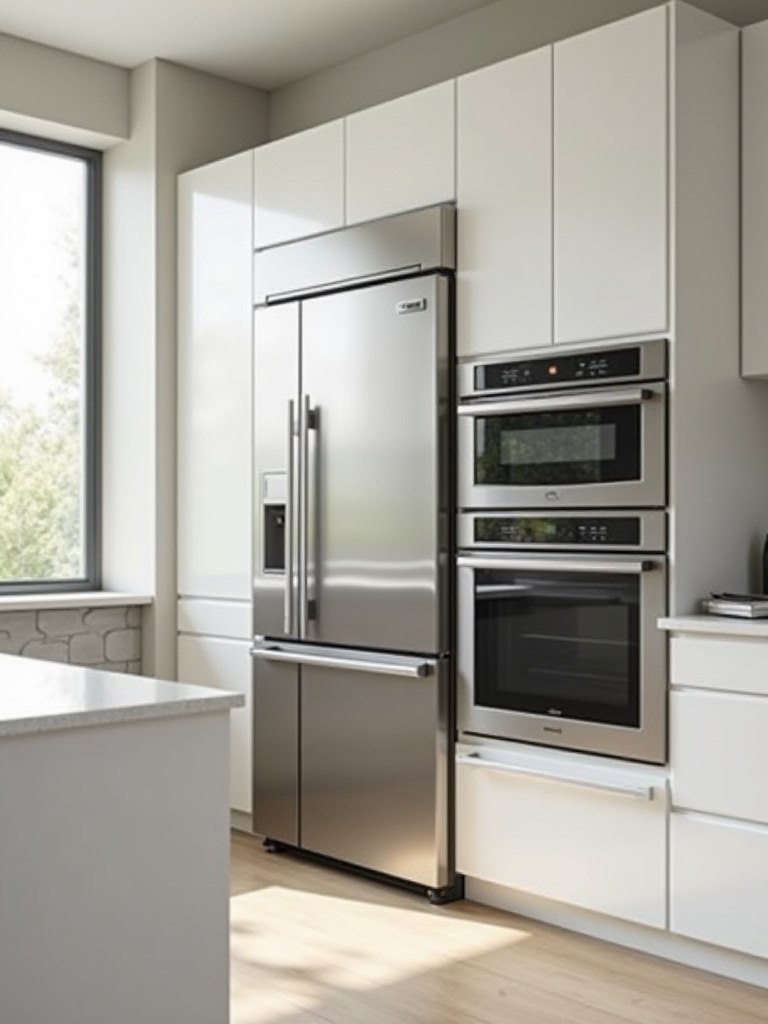
But beyond that, let’s talk about the joy of cooking. Appliances should feel good to use. A gas range with a powerful, responsive flame is a beautiful thing for someone who loves to cook. An induction cooktop offers incredible precision and is incredibly efficient. What matters isn’t just the ENERGY STAR rating, but how these tools will support your creativity and your daily rituals in the kitchen.
Instead of getting bogged down in specs, think about the experience. Go to a showroom and turn the knobs. Open the oven door. Imagine yourself preparing your favorite meal. Choose the appliances that feel like extensions of your own hands, the ones that will be your trusted partners in the kitchen for years to come.
9. Prioritize Functional Cabinetry Designs: Shaker vs. Flat Panel Pros & Cons
Shaker or Flat Panel? My friend, we can do so much better than that. This is the biggest surface area in your kitchen—it’s your canvas! Instead of thinking in terms of just two generic styles, think about color, texture, and character. Why not paint your cabinets a deep, vibrant cobalt blue, inspired by Frida Kahlo’s Casa Azul? Or a warm, sun-faded yellow that reminds you of a hacienda?
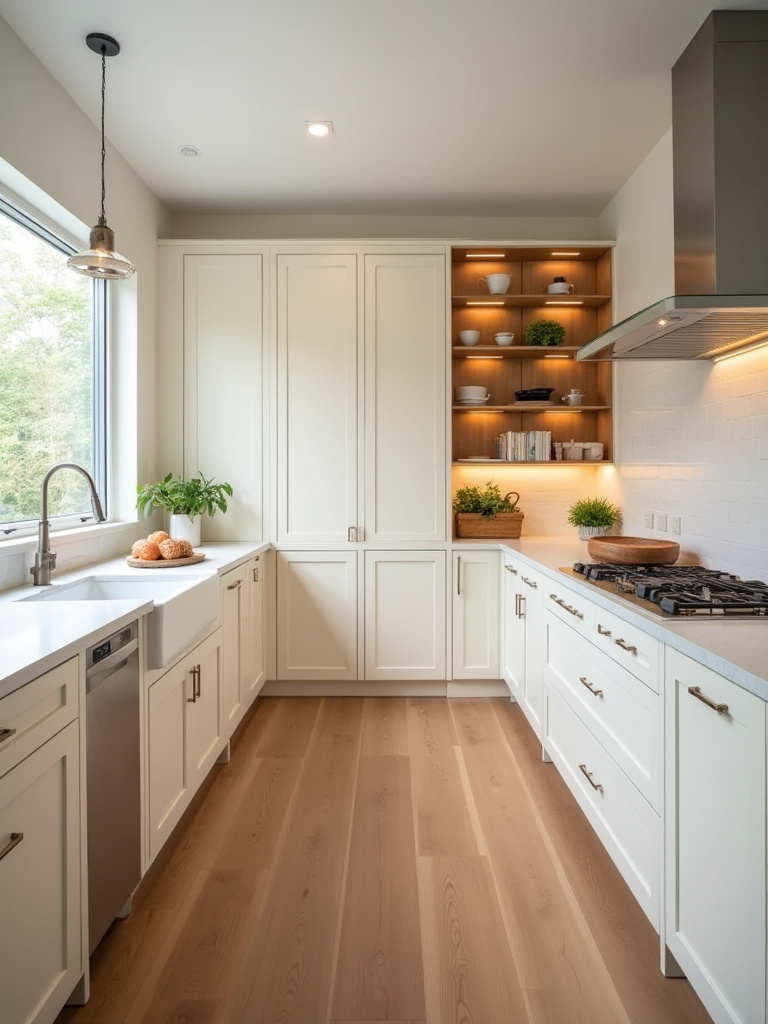
I had a client who inherited her grandfather’s home, filled with beautiful, dark wood furniture. For her kitchen, we designed simple, flat-panel cabinets but had them made from a rich, reclaimed alder wood. We let the natural beauty of the grain be the star. For another project, we found an incredible artisan in New Mexico who did traditional chip-carving, and we had him create a stunning detail on just a few of the upper cabinet doors. It turned simple cabinets into a piece of art.
The shortcut here is this: a simple cabinet style, like a Shaker or a flat slab, can be the perfect backdrop for what really matters—a breathtaking color, beautiful wood, or some truly special, hand-forged hardware. Function is key, yes, so get the deep drawers and pull-outs. But let the fronts be a reflection of your personality.
10. Integrate Thoughtful Lighting Layers: Task, Ambient, Accent
Lighting is the magic ingredient. It’s the single most powerful tool you have to change the entire mood of your kitchen. Don’t just stick a bunch of recessed cans in the ceiling and call it a day. That’s like a spotlight in an operating room—functional, but hardly inviting. You need layers of light, like you’d layer flavors in a good mole sauce.
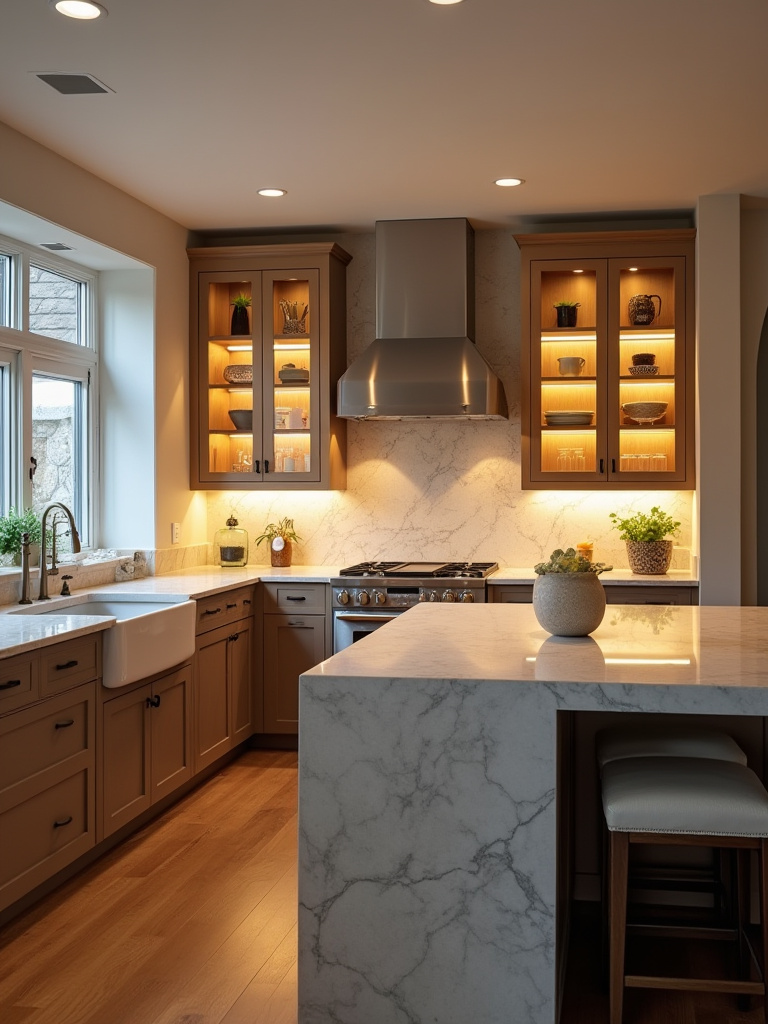
Start with your ambient, or overall, light. This can be your recessed lighting, but make sure it’s on a dimmer. Absolute non-negotiable. Then you add task lighting—bright light right where you need it, like under the cabinets over your prep space. But the final, most important layer is the accent lighting. This is the soul. This is your chance to add a showstopper—a beautiful hand-blown glass pendant from Guadalajara over your island, or a pair of wrought-iron sconces flanking the sink. This is the warm, glowing light that makes everyone look beautiful and feel welcome.
I learned this the hard way on an early project where we got all the practical lighting right, but the room felt… cold. We went back and added a single, beautiful ceramic pendant light over their small kitchen table. It cast a warm, intimate pool of light. Suddenly, that’s where everyone wanted to be. It completely changed the heart of the room.
Smart Selections & Seamless Installation of Core Components (Part 2)
This is the nuts-and-bolts part, I know. But getting this infrastructure right means all the beautiful things we’ve talked about will actually work and last. Think of this as building the strong bones so the beautiful soul can shine through.
11. Secure Expert Plumbing & Electrical Updates for Safety & Modernity
I’m going to keep this one short and sweet because, let’s be honest, no one gets excited about plumbing pipes. But you absolutely cannot cut corners here. Old wiring is a fire hazard. Old pipes can leak and ruin your beautiful new cabinets. This is the foundation of your kitchen’s health and safety.
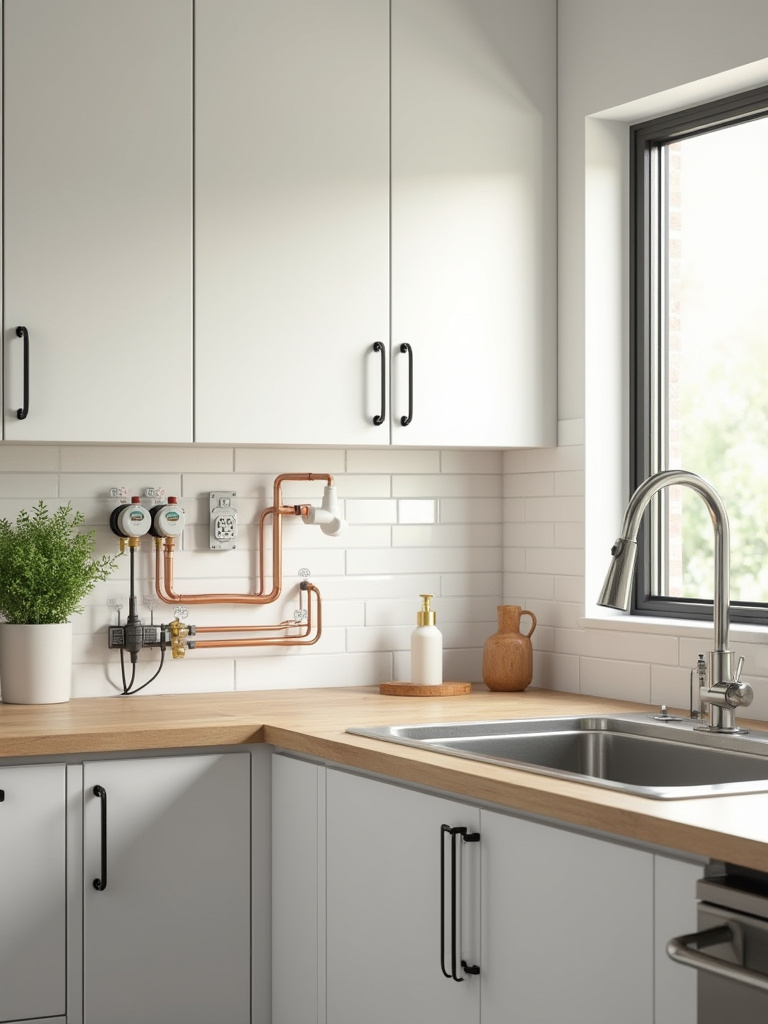
Hire the best licensed plumber and electrician you can find. Don’t even think about letting a general handyman do this work. It’s a specialty. Think ahead, too. Want a coffee station with a fancy plumbed-in machine one day? Run the water line now while the walls are open. Want beautiful pendant lights over an island you might add later? Run the electrical for it. This is your chance to build a rock-solid foundation for today and for the future.
This is non-negotiable, behind-the-scenes work that makes everything else possible. So just do it right, and then we can get back to the pretty stuff.
12. Oversee Delivery & Installation Schedules to Prevent Delays
Ah, the dance of logistics. When you choose to work with artisans and source unique materials, you have to embrace a different rhythm. Those handmade tiles from Mexico? They won’t arrive overnight from a warehouse. They are being made for you, by hand, and that takes time. The key is to build that time into your schedule from the very beginning.
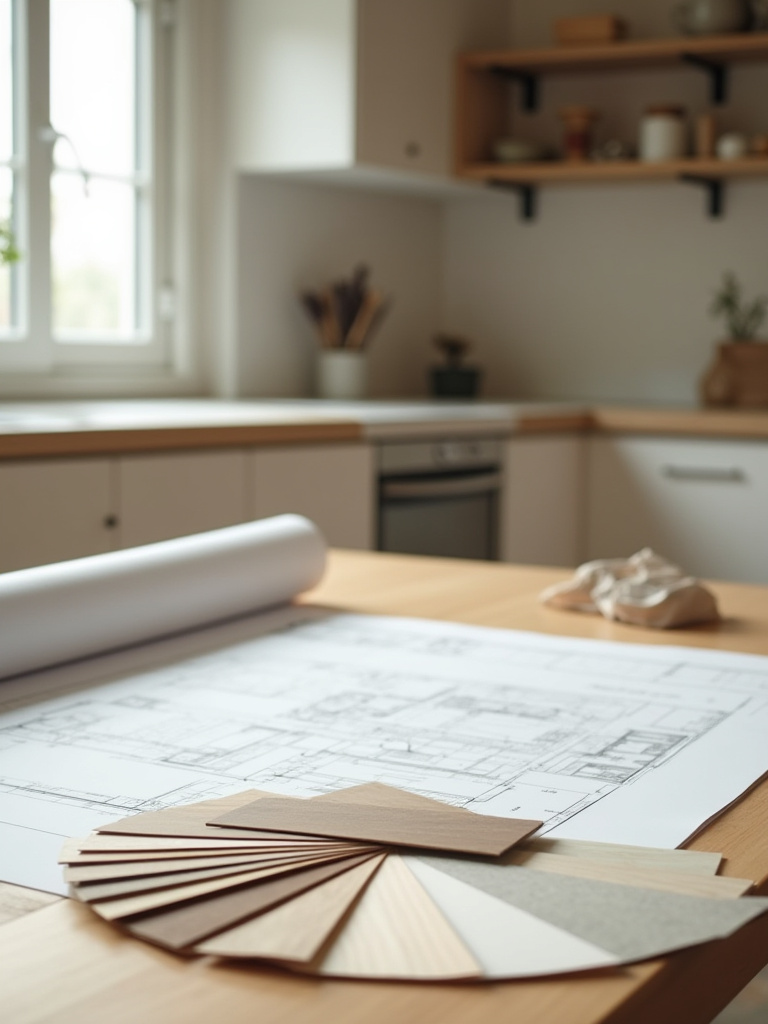
My advice is to have everything—and I mean everything: cabinets, appliances, tile, hardware, lights—on-site before your contractor starts the demolition. The biggest budget-killer is paying a crew to stand around waiting for a delivery. It can be a challenge to store it all, I know, but it is so much less stressful than having your home be a construction zone for weeks longer than necessary because your faucet is stuck on a boat somewhere.
Embrace the concept of “slow design.” The wait is part of the story. The anticipation of watching a skilled tiler lay your backsplash piece by piece is part of the joy. Just plan for it, communicate constantly with your suppliers, and be patient. The result is always worth it.
Elevating Aesthetics & Enhancing Functionality with Finishing Touches (Part 1)
This is my favorite part! The details! This is the jewelry, the spice, the finishing touch of cilantro and lime that makes the whole dish come together. These are the elements that make a kitchen uniquely, wonderfully yours. Don’t treat them as an afterthought.
13. Pick a Backsplash That Adds Visual Interest Without Overwhelming
The backsplash is not just a wall protector; it is a canvas for art. Forget boring, soulless subway tile unless you’re using beautiful, handmade ones with subtle variations. This is your chance to make a statement, to add color, pattern, and story. Think of the vibrant, cobalt blue and white of Talavera tiles from Puebla. You could do a whole wall, or just a beautiful, focused mosaic behind the range.
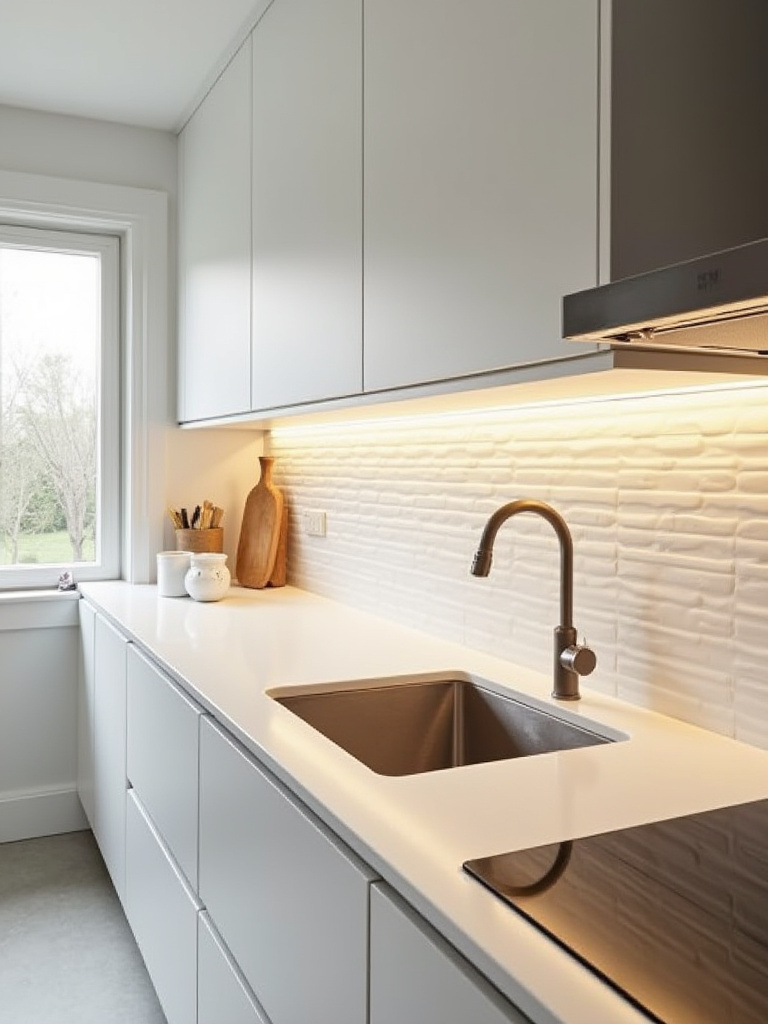
For one client who wanted a warm, rustic feel, we used simple, square terracotta tiles, known as Saltillo tiles. But we laid them in a herringbone pattern. The texture and the warmth were incredible, and the simple shift in pattern made it feel so special. Another option I love is Zellige tile from Morocco—each tile is hand-cut and has its own unique glaze and imperfections. When they are on the wall together, the way they reflect the light is simply breathtaking.
The key is to let your backsplash be a focal point, a piece of art that you get to live with every day. Choose something made by human hands, and you will feel that energy every time you step into your kitchen.
14. Curate Cabinet Hardware for a Cohesive Style Statement
Oh, cabinet hardware. It is such a small detail, but it has such a huge impact. It is the one thing in your kitchen you will physically touch dozens of times a day. It should feel good in your hand. It should have some weight, some substance. This is not the place to skimp.
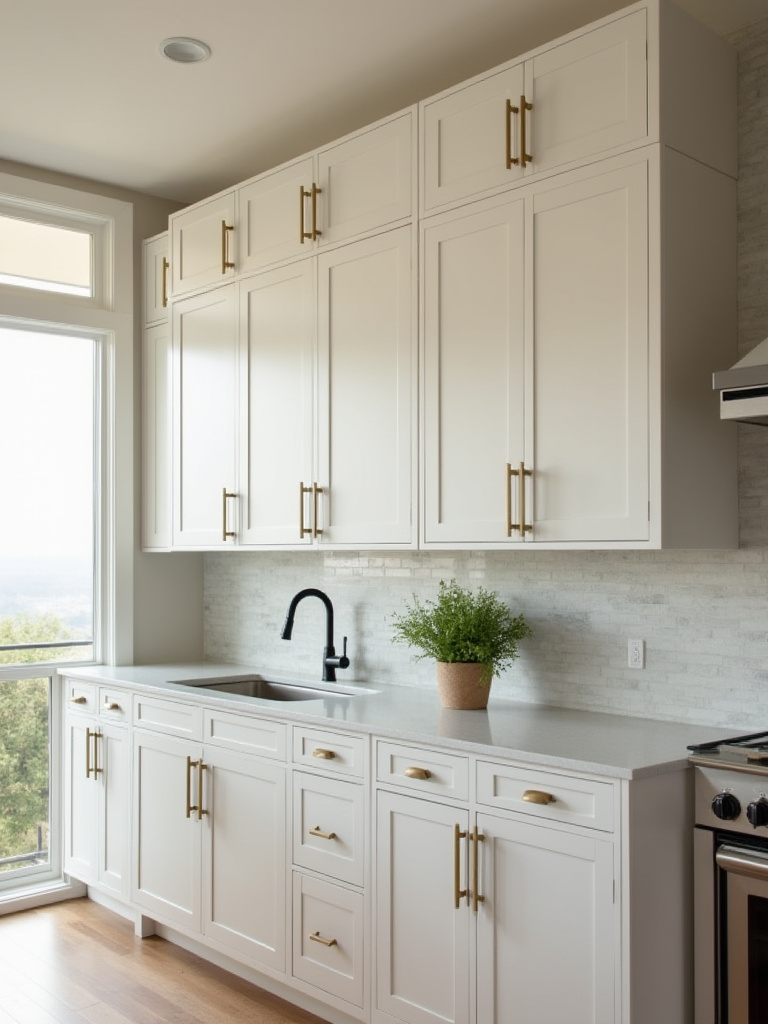
Steer clear of the bulk bins at the big box stores. Look for something with character. There are incredible artisans who forge iron pulls by hand. There are ceramicists who make beautiful, hand-painted knobs. For a contemporary space, a simple, elegant brass pull can feel like a piece of sculpture. For a rustic kitchen, I love using leather pulls, which get softer and more beautiful with age.
I once found these amazing, weighty, hand-hammered copper knobs at a market in San Miguel de Allende. I bought a whole bag of them without even having a project in mind. A year later, a client wanted a touch of warmth in their otherwise sleek, modern kitchen. We put those knobs on her simple white cabinets, and it was transformative. It was the one detail that added history and soul.
15. Invest in Resilient & Aesthetically Pleasing Kitchen Flooring Options
The floor grounds your entire kitchen. It needs to be tough, absolutely, but it also needs to set the tone. One of my all-time favorite materials is terracotta, or Saltillo, tile. Yes, it needs to be sealed properly. And yes, it will show wear over time. But that patina is gorgeous! It warms up an entire room and feels incredible underfoot. It’s been used for centuries for a reason.
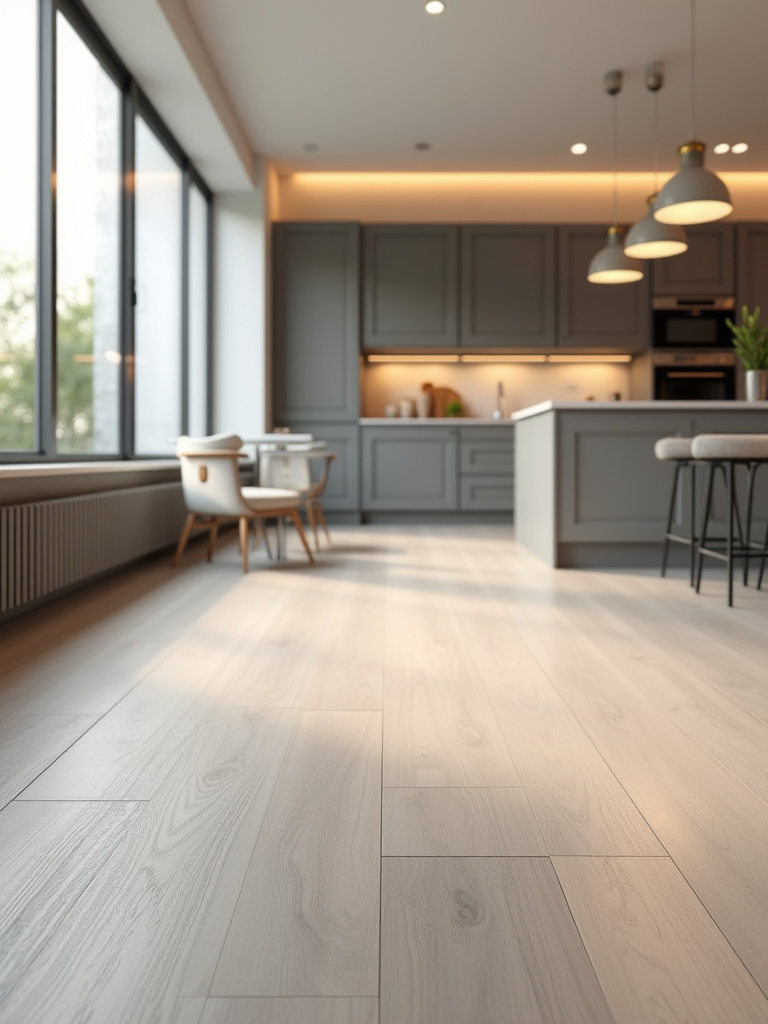
Another amazing option is cement encaustic tile. These have been made in Latin America and Europe for generations. The pattern isn’t just painted on the surface; it’s made from different colors of cement, so the pattern runs all the way through the tile. As they wear, they just get more beautiful. You can go for a bold, colorful pattern to make the floor the star of the show, or a more subtle, tonal pattern for texture.
These materials are not about perfection. They are about embracing the beauty of natural materials and the story of time. They will last forever and will only get more beautiful as your family creates memories on them.
16. Integrate Clever Pantry Organization Systems for Accessibility
Even the most practical part of a kitchen can be beautiful. An organized pantry is a joy, but it doesn’t have to be filled with rows of sterile plastic containers. Think about using natural, beautiful materials for your organization. Woven baskets are perfect for holding root vegetables or snacks. A collection of beautiful glass jars for grains and pastas can be stunning.
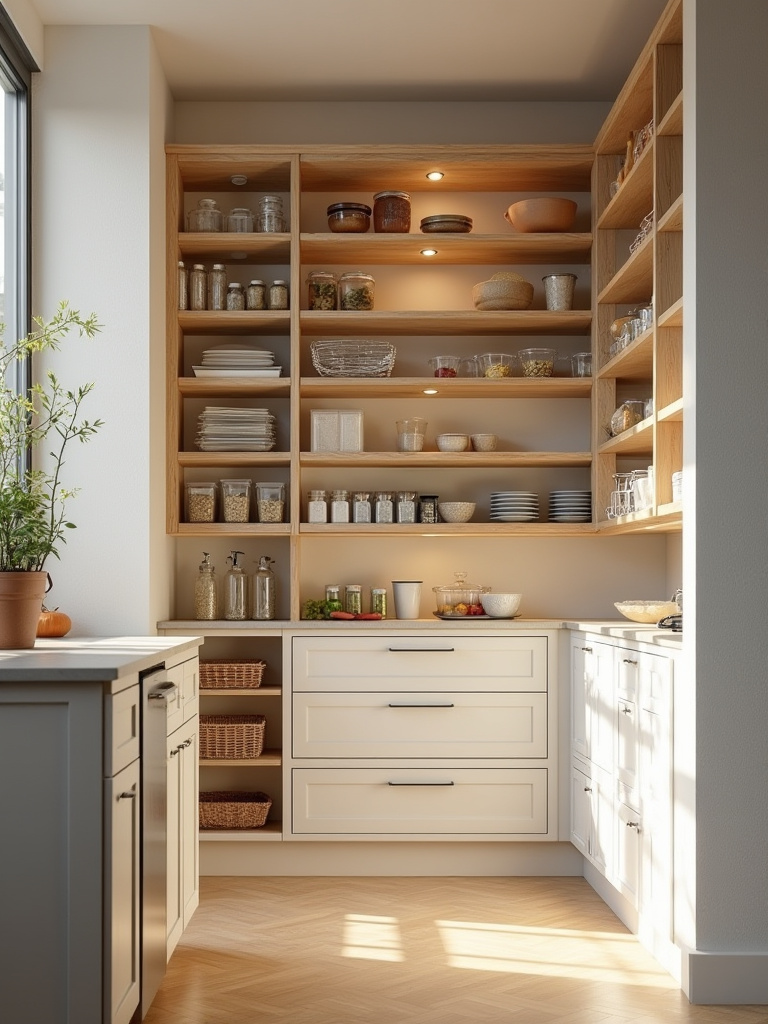
I love using open shelving in a pantry and decanting everything. Not only does it look beautiful, like an old-world apothecary, but it’s practical. You can see exactly what you have, so you buy less and waste less. It encourages you to be mindful. Using beautiful, hand-thrown ceramic canisters for things like coffee, sugar, and flour can turn a simple shelf into a curated display.
This is about creating beauty even in the hidden spaces. When you open your pantry door, it shouldn’t feel like an explosion of clutter. It should feel like a calm, curated little shop, filled with all the ingredients for the delicious meals you’re about to create.
Elevating Aesthetics & Enhancing Functionality with Finishing Touches (Part 2)
We’re in the home stretch! This is about adding those final layers of personality that make the kitchen feel truly lived-in and loved. It’s about creating small moments and destinations within the larger space, making it a place you never want to leave.
17. Design a Dedicated Coffee or Beverage Station for Daily Convenience
Let’s not call it a “beverage station.” That sounds so clinical. Let’s call it your Cafecito Corner. A small, dedicated space to honor the sacred ritual of your morning coffee. This can be as simple as a little nook of your countertop, or a dedicated cabinet with a pull-out shelf. It’s about creating a moment of peace in your day.
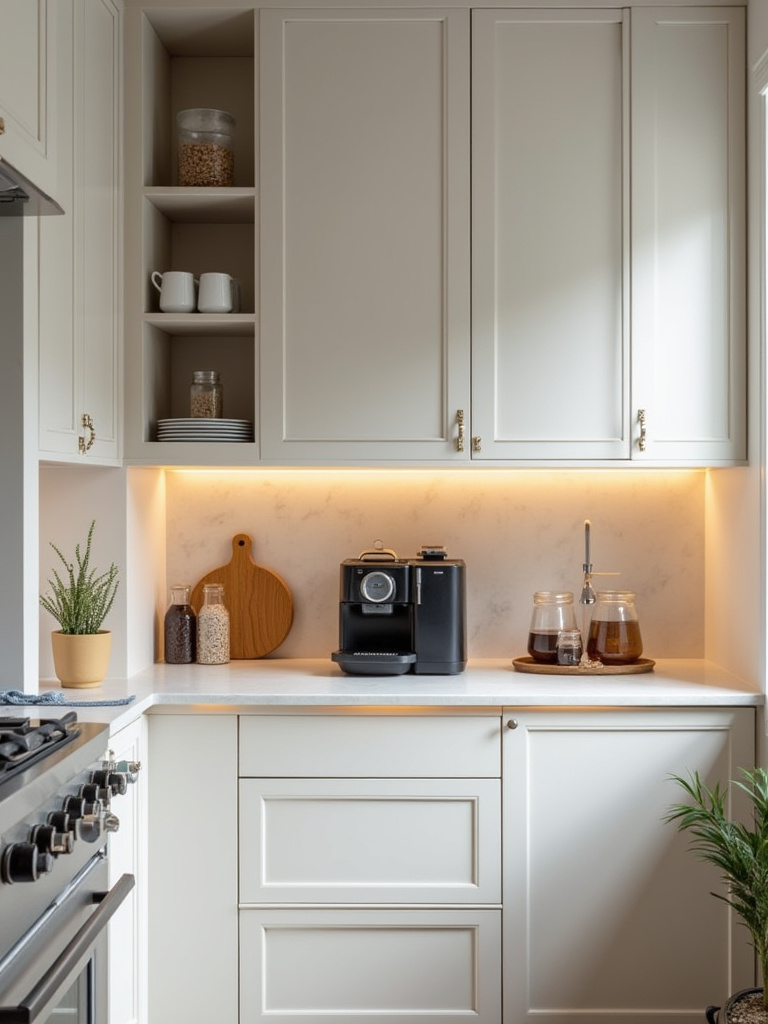
Gather all the beautiful elements here. Your favorite hand-painted mugs hanging from small hooks. Your coffee beans in a beautiful ceramic jar. A small, colorful tray to hold the sugar and spoons. Maybe a small piece of art on the wall above it. In my own home, my Cafecito Corner is where I have a small plant and a framed photo that makes me smile. It’s more than just where the coffee maker lives; it’s a tiny altar to the start of my day.
This little corner becomes a destination. For entertaining, it can easily become a bar for making cocktails or serving wine. It’s a small detail that signals hospitality and care.
18. Add Personalized Decor Elements: Open Shelving, Artwork, Plants
A kitchen without art and life is just a room with appliances in it. You absolutely must bring in elements that are personal to you. Open shelving is a perfect way to do this. But please, curate it. Don’t just stuff it with all your dishes. Choose your most beautiful pieces—a stack of colorful bowls, a piece of folk art, your favorite cookbooks, a small, trailing plant in a beautiful maceta.
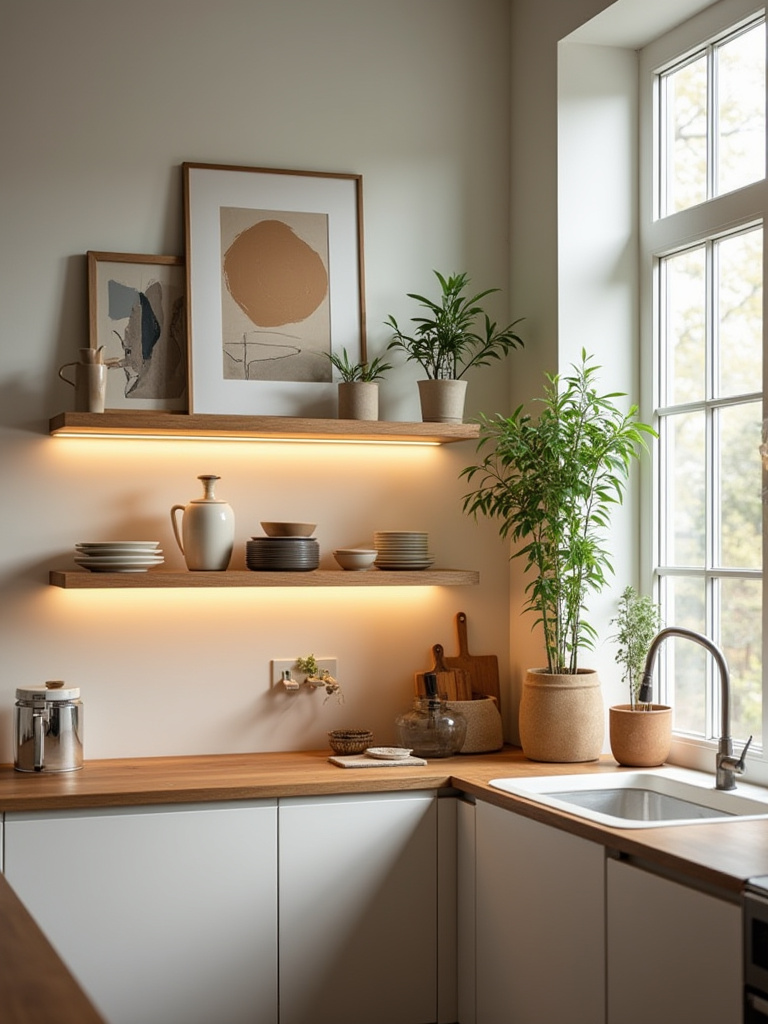
“A home should be a collection of what you love. If you fill your kitchen with things that tell your story, it will always feel beautiful and welcoming.”
And plants! ¡Por favor! You need plants. A pot of herbs on the windowsill not only looks and smells beautiful, but it’s practical. A hanging pothos can soften a corner. Plants literally breathe life into a space. They make it feel vibrant and healthy. Choose beautiful pottery for your plants—don’t just leave them in their plastic nursery pots. Let the pot be as much a part of the design as the plant itself. This is how you make a house a home.
Long-Term Value & Smart Living in Your Renewed Kitchen (Part 1)
Thinking about the long-term isn’t just about money. It’s about creating a space that is sustainable, smart, and a true joy to live in for many years. It’s about building a kitchen that will support your life and evolve with you.
19. Implement Smart Home Technology for Enhanced Kitchen Control
I’ll be honest, the idea of a “smart” kitchen can feel cold and robotic. But I encourage you to think of this technology not as the star of the show, but as a quiet, helpful assistant. The goal is not to have a kitchen that talks to you, but to have technology that makes your life easier so you have more time for the things that matter—like spending time with your family.
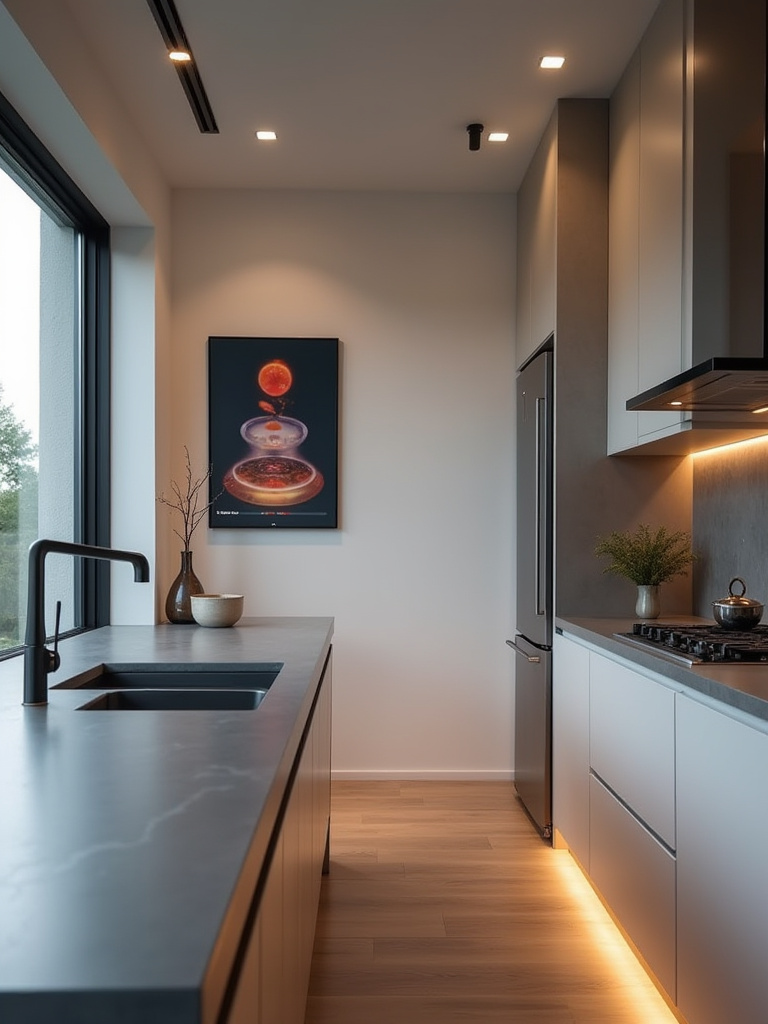
A voice-activated faucet is a wonderful thing when your hands are covered in dough. A smart oven that you can preheat on your way home from work means you can have dinner on the table faster. The key is to integrate this technology seamlessly, so it feels intuitive, not intrusive. Hide the speakers. Integrate the controls. Let it work its magic behind the scenes.
Think of it this way: for generations, people have used clever tools to make cooking easier. This is just the 21st-century version. Use it to support the life you want to live, not to replace the human element of cooking and gathering.
20. Maximize Natural Light & Consider Sun Exposure in Design
Light is life. It is the one design element you can get for free, and it is the most powerful. A sun-drenched kitchen is a happy kitchen. When you are planning your renovation, think about how you can bring in as much natural light as possible. Can you enlarge a window? Add a glass door to the outside? Can you put in a skylight?
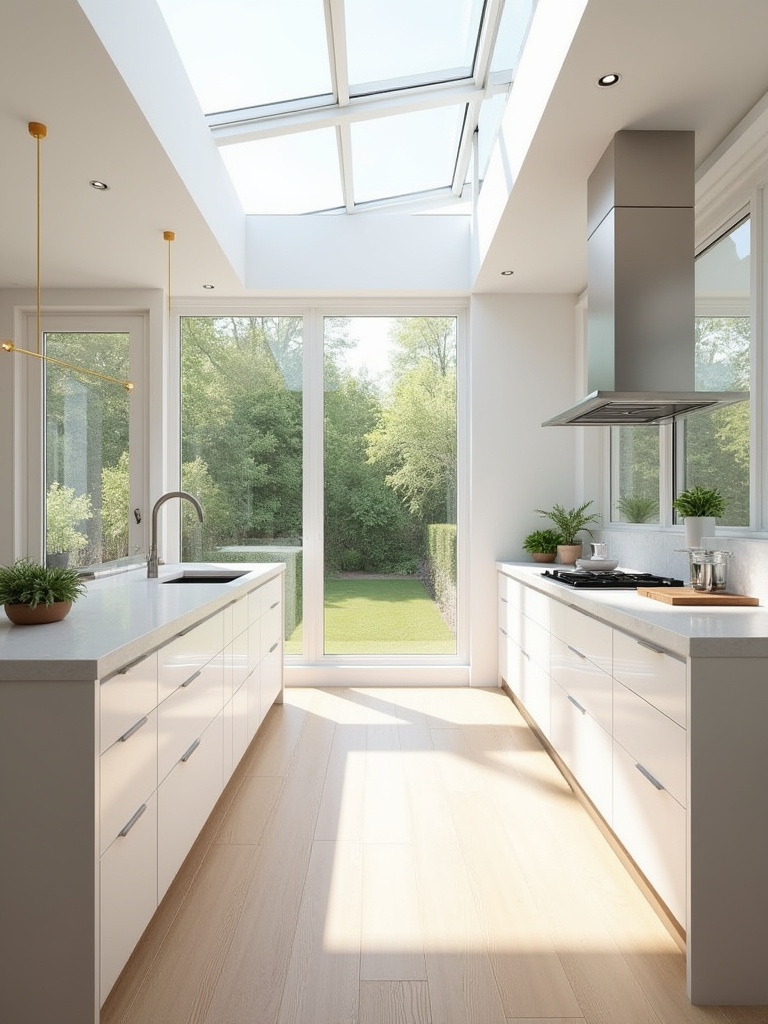
The way light plays on different surfaces is magical. It will make your colorful tiles glow. It will warm up your wooden countertops. It will make the whole space feel more open and alive. I once worked on a dark, narrow kitchen where we installed a “sun tunnel,” which is a small, reflective tube that pulls sunlight from the roof down into the room. It was astonishing. It felt like we had switched on a permanent, happy light bulb.
Pay attention to how the light moves through the space during the day. This will help you decide where to put your breakfast nook to catch the morning sun, or where to put a comfortable chair for reading in the afternoon. Embrace the light. It’s the best designer there is.
21. Select Low-Maintenance Materials for Easier Cleaning & Upkeep
Low-maintenance should not mean lifeless. Often, people think this means choosing plastic-y, synthetic materials that feel sterile. I believe the most truly low-maintenance materials are the ones that age gracefully and don’t require you to be precious with them. A big, single-basin sink in soapstone or stainless steel is incredibly easy to clean. You can scrub it without worry.

Terracotta floors, once properly sealed, are incredibly durable. They hide crumbs, and as they get small nicks and marks, it just adds to their character—it’s called patina, and it’s a beautiful thing. Compare that to a shiny, perfect surface where every single fingerprint and speck of dust shows, driving you crazy. I’d much rather have a floor with a story than a floor that looks like a pristine mirror.
It’s a shift in mindset. Instead of fighting against wear and tear, choose materials that embrace it as part of a life well-lived. That is the ultimate in low-maintenance living.
22. Create Dedicated Zones for Specific Activities (e.g., Baking, Prep)
This idea of “zones” sounds very technical, but it’s really about creating intuitive spaces for the activities of your life. A baking zone is simply having a corner with your mixer, your flour and sugar in beautiful jars, and your baking sheets stored neatly below. It means you don’t have to drag everything out from all corners of the kitchen every time you want to make cookies.
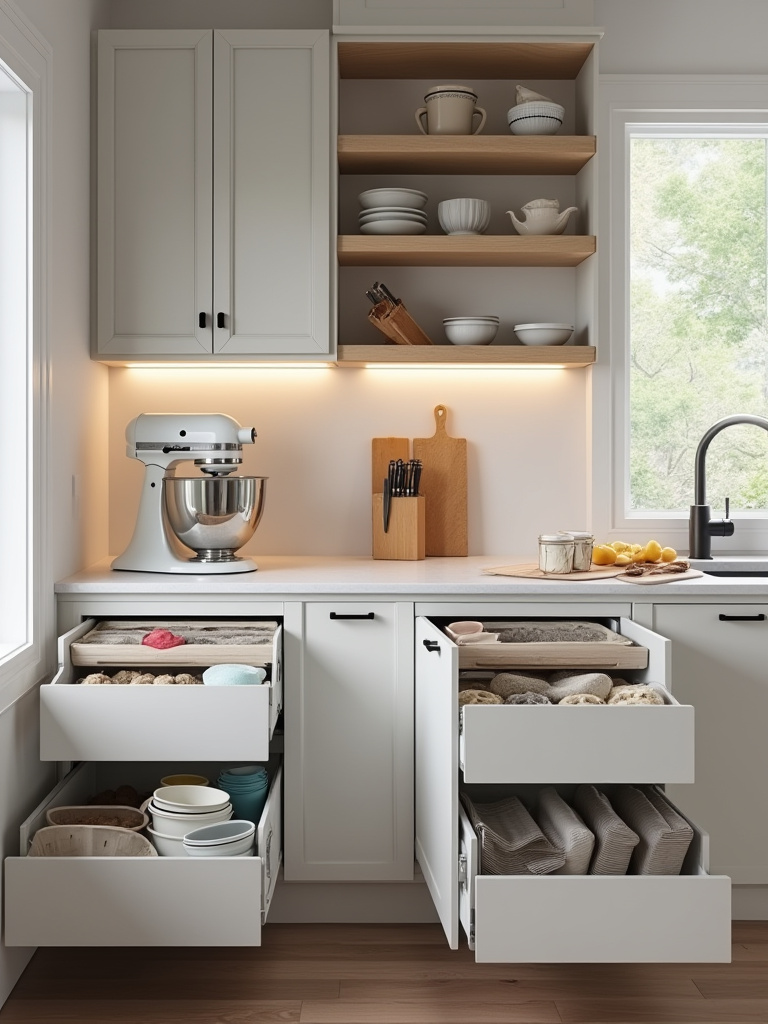
Think about the rhythm of your cooking. I like to have a “chopping zone” right next to my compost bin, with my knives and cutting boards within arm’s reach. My “cooking zone” is around the stove, with oils, spices, and utensils right there. It’s not about rigid rules; it’s about common sense and creating a flow that feels effortless.
This is especially helpful when you have multiple people cooking together. Someone can be at the prep zone washing lettuce for a salad, while someone else is at the stove sautéing onions, and no one is bumping into each other. It makes the kitchen a more harmonious place for collaboration and community.
Long-Term Value & Smart Living in Your Renewed Kitchen (Part 2)
We’ve built a beautiful, soulful space. Now, how do we care for it and ensure that it was built in a way that is good for us and good for the planet? This is about finishing strong, with integrity and mindfulness.
23. Develop a Post-Renovation Maintenance Schedule for Longevity
When you invest in beautiful, handcrafted things, caring for them isn’t a chore; it’s a ritual. You’ve chosen materials with life and character, and they need a little love to stay their best. Oiling a butcher block countertop every month is a satisfying, meditative task. Cleaning your terracotta floors with a gentle, natural soap brings out their rich color.
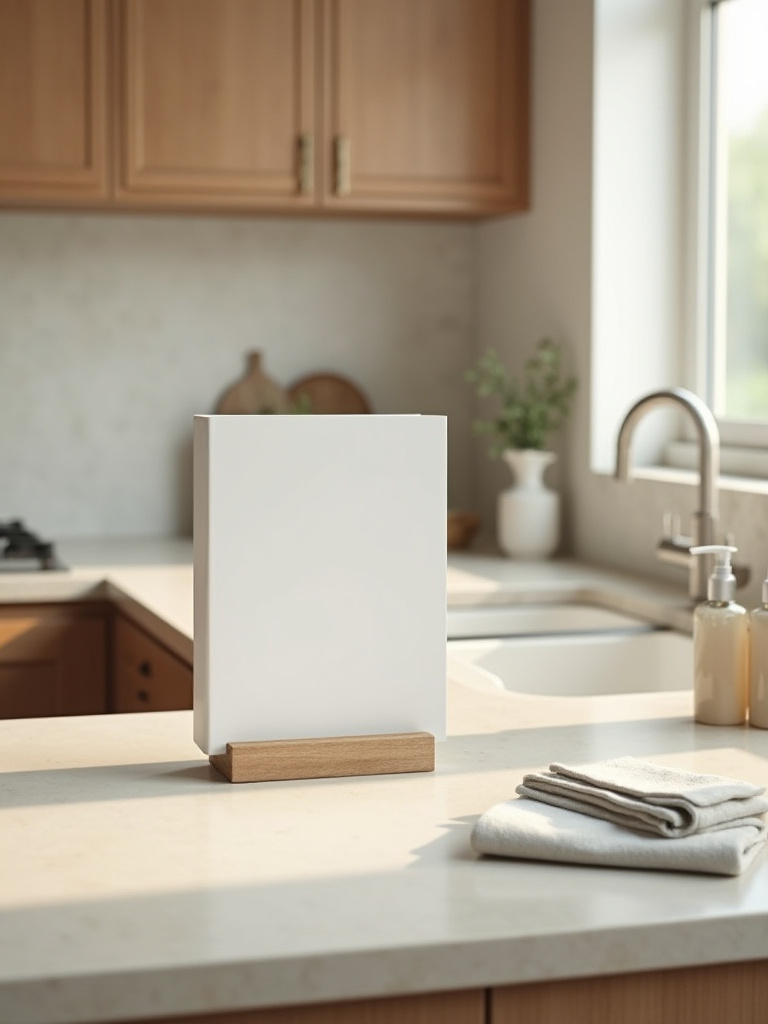
Create a simple guide for yourself. Put it inside a kitchen cabinet. List all your new materials and appliances and how to care for them. What cleaner is safe for your countertops? How often do you need to seal the grout? Taking care of these small tasks regularly will prevent big problems down the road and will keep your kitchen looking and feeling beautiful for decades.
This isn’t about striving for perfection. It’s about stewardship. It’s about honoring the materials and the craftsmanship you invested in. When you care for your home, your home cares for you in return.
24. Explore Sustainable & Eco-Friendly Material Choices
This, to me, is the most important point of all, and it beautifully circles back to everything we’ve discussed. Choosing sustainable and eco-friendly materials is often synonymous with choosing artisanal materials. When you buy reclaimed wood, you are diverting waste from a landfill. When you buy tiles from a small, local workshop, you are supporting a local economy and reducing the carbon footprint of shipping things across the world.

Sustainability is about choosing things that last. It’s the opposite of a throwaway culture. It’s about choosing low-VOC (volatile organic compound) paints and finishes, which are better for your family’s health and the air you breathe. It’s about valuing the resources of our planet and the skill of human hands. I believe a truly beautiful kitchen is also a healthy and responsible one.
So, when you are making your choices, ask questions. Where did this wood come from? Who made this tile? What is this finish made of? Making conscious choices is the ultimate investment in the long-term value of your home and the well-being of your family.
Conclusion
So there you have it. Creating your dream kitchen isn’t about following a set of rules or chasing a trend. It’s a journey of uncovering your own story and embedding it into the walls of your home. It’s about choosing color, texture, and light that make you feel happy and at peace. It’s about making space for connection, for community, and for the beautiful, messy business of life.
Your kitchen should be a celebration of who you are. Fill it with things that have meaning, things made by hand, things that will get more beautiful with age. The heart of your home deserves to have a soul. Don’t be afraid to break the rules, to be bold, and to create a space that is unapologetically, wonderfully you.
